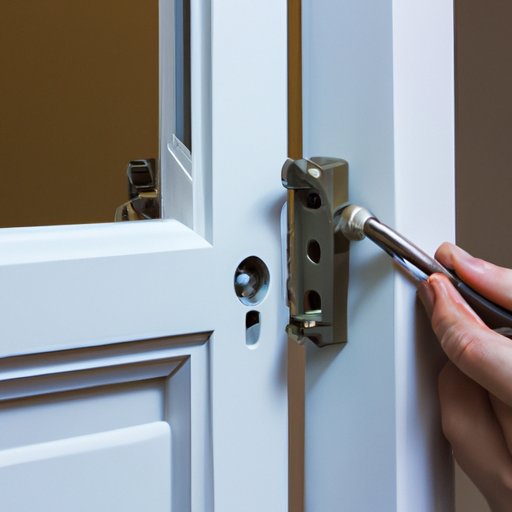
Introduction
Installing a door is an important home improvement task that can add both security and aesthetic value to your home. However, it can be an intimidating process for those who have never done it before. This article will provide a comprehensive step-by-step guide on how to install a door, explain the tools you need, explore the different types of doors, and offer tips on how to avoid common mistakes. By the end of this article, you will have the knowledge and confidence to install a door yourself.
A step-by-step guide on how to install a door
Preparing the door frame
The first step in installing a door is to prepare the door frame. This involves removing any old hardware and trim that is attached to the frame. If necessary, use a pry bar and hammer to remove the old hardware and trim, making sure not to damage the frame.
Next, check the opening for squareness by measuring the diagonal dimensions. If the measurements are not equal, you will need to adjust the frame before proceeding.
Measuring and cutting the door
Once the frame is prepared, it’s time to measure and cut the door to size. To take accurate measurements, use a measuring tape to measure the width and height of the opening. Add an additional 1/2 inch to the width for clearance and 1 inch to the height for the gap between the bottom of the door and the floor. Use a saw to cut the door to the appropriate size.
Installing the hinges and doorknob
Now it’s time to install the hinges and doorknob onto the door. Start by positioning the door in the frame and marking the locations of the hinges and doorknob. Use a drill to make the holes for the hinges and doorknob, making sure they are the appropriate size and depth. Attach the hinges to both the door and the frame, then attach the doorknob and latch to the door.
Finishing touches
Finally, install the strike plate onto the frame and make any necessary adjustments to ensure the door fits snugly and operates smoothly. Add weatherstripping to the frame to prevent drafts and add a door stop to prevent the door from swinging too far open.
Understanding the tools you need to install a door
Installing a door requires several tools. These include screwdrivers, saws, chisels, measuring tape, and a drill. A screwdriver is used to attach the hardware to the door and frame, while a saw is used to cut the door to size. A chisel is used to make mortises for the hinges, and a measuring tape is used to ensure accurate measurements. A drill is used to make holes for hardware and the latch.
Tips to avoid common mistakes during door installation
Incorrect measurement
One of the most common mistakes when installing a door is incorrect measurement. To avoid this, make sure to take accurate measurements and double-check them before cutting the door to size. Measure the width and height of the opening, add clearance and gap distances, and then measure again to ensure accuracy.
Inconsistent spacing
Another common mistake is inconsistent spacing, which can lead to problems with hardware installation and operation. To avoid this, measure and mark the spacing locations before drilling and use a level to ensure they are consistent.
Exploring the different types of doors
Sliding doors
Sliding doors offer a unique installation process, as they require a track to be installed on the frame. Make sure to measure and install the track correctly, and ensure the door slides smoothly and securely.
Folding doors
Folding doors also have a unique installation process, as they require multiple hinges to be installed in a specific pattern. Make sure to follow the manufacturer’s instructions carefully and test the operation before finishing installation.
Hinged doors
Hinged doors are the most common type of door and have a straightforward installation process. However, make sure to install the hinges in the correct location and ensure the door is plumb and level before finishing installation.
Cost-effective ways to install a door
Installing a door can be an expensive project, but there are ways to cut costs without sacrificing quality. Consider using recycled or reclaimed doors, opting for a DIY installation project, or purchasing a pre-hung door for ease of installation. Make sure to research options carefully and plan the project in advance to avoid unexpected costs.
Conclusion
Installing a door is an important task that can add value and security to your home. By following this comprehensive step-by-step guide, you can install a door yourself and save money on installation costs. Remember to follow the manufacturer’s instructions carefully, take accurate measurements, and test the operation before finishing installation. With these tips and tricks, you can install a door like a pro.




